Abstract
This study analysed changes in demographic, gender, basic service access and agricultural production patterns in the rural black Eastern Cape Province between 1993 and 2002 in order to offer advice for future poverty alleviation strategies. It used secondary data from national surveys and the 2001 census and stratified the Eastern Cape districts into former Transkei, former Ciskei and commercial farming district sub-regions, in accordance with the pre-1994 developmental scenarios. The results showed that the demographic and basic service access changes were positive, but that pre-existing sub-regional differences had been reinforced, indicating that the populous former Transkei was being marginalised. There has been little development for rural women, agricultural production is almost negligible and employment in commercial farming has declined. Geographically targeted interventions seem to be warranted for the demographic, gender development and basic service accessibility aspects of Eastern Cape rural poverty, but improving rural production appears to be the major challenge.
1. Introduction
The living standards of human populations are a major challenge for contemporary societies. At the 1996 World Food Summit and the 2000 Millennium Summit, world leaders committed themselves to reducing poverty by half by 2015. Bage (Citation2002:2) argued for a focus on poverty where it really is, in the rural areas, where both the social and the agricultural sectors warrant developmental interventions. The present study focused on sub-provincial regional trends in selected aspects of poverty in the rural Eastern Cape Province (ECP), with the aim of identifying what we have achieved and where we are lagging behind.
The 2001 census showed the ECP as having the third largest population of South Africa's nine provinces, with approximately 68 per cent living in rural areas and Population Policy for South Africa (Department of Welfare, Citation1998) described South Africa as demographically characterised by large rural populations that are without an adequate productive base, infrastructure and services. The Human Development Index (HDI) analysis (Whiteford et al., Citation1995) indicated that the living conditions of rural blacks in some ECP districts compared with those of some of the poorest populations in the world. This analysis also reflected significant variations between the ECP rural districts and regions, thus establishing a basis for priority intervention areas. The present analysis is based on a sub-provincial geographic stratification of the rural ECP as constituted by the former Transkei, the former Ciskei and the commercial farming districts (CFDs). This stratification assumed that the poverty and developmental conditions under which the designated sub-regional populations lived were significantly different before the inception of poverty alleviation strategies that followed the 1994 political changes. Such differences may have made the impacts of the interventions uneven, causing unintentional marginalisation of some rural populations. Intervention in these areas therefore has to be considered a priority.
This Introduction incorporates a review of some of the literature concerning the aspects of poverty selected for analysis in this study, to put the analyses that follow into perspective. Section 2 explores the demographic changes underlying the poverty scenario in each of the delimited rural ECP sub-regions. Changes in the gender and social development challenges for rural women receive attention in Section 3, patterns of energy use and clean water and sanitation accessibility are described in Section 4, Section 5 considers agricultural production in the former Transkei and Ciskei sub-regions and the concluding section discusses the employment scenario in the CFDs.
1.1 Literature review
With South Africa having achieved a democratic dispensation, questions are being asked about the continuing widespread poverty. Smith Citation(1997), for instance, questioned the flouting of human rights among poor rural populations living in precarious conditions. He described the establishment of what he called ‘clientelistic dependency’ relationships between poor households and better-off patron households, which are intended to support poor households through periods of crisis. Such relationships, he argued, often impair the poor households' capacity to use their civil and political rights, in deference to or in anticipation of the patron's preferences. Torres et al. (Citation2000:75) described the vulnerability of farm workers in South Africa, who rely on their employers not only for employment and wages but also for services such as schools, housing and electricity and access to medical facilities, water and transport. They noted that the farmer has extensive control over virtually every aspect of the workers' lives.
On employment dynamics, Bartoli (Citation2000:18) outlined the labour market human rights dilemmas that arise from insecurity of employment, noting that employment is precarious, with workers facing the threat of unemployment or actually becoming unemployed. Such insecurity generates both health and behavioural disorders, coupled with feelings of being betrayed or destroyed, along with endeavours to escape through conflict, illness, flight and survival techniques such as alcohol and drug abuse. He described the emotional and social burden of unemployment as staggering, especially when considered against the background of rural poverty.
On employment among the poor South African farm workers, Torres et al. (Citation2000:75) pointed out that the poor have no secure jobs and that poor communities are characterised by the widespread absence of formally employed people. They noted that male unemployment had income and social costs, potentially generating violence and gender conflict. They cited studies that reveal poor people's need for reliable and secure forms of income but made no reference to the anxieties associated with seasonal and casual jobs. In addition, Torres et al. Citation(2000) observed that farm work in South Africa is changing from permanent towards seasonal and casual jobs, while the main trend has been labour shedding because of improvements in technology, changing incentives and episodes of drought. They concluded that all these factors make the workers in this sector more vulnerable.
The mining sector in South Africa traditionally employed large numbers of rural unskilled workers, but its contraction in recent years has resulted in the shedding of many jobs. The October Household Survey (Statistics South Africa, Citation1995) indicated that 78 per cent of employees in this sector were black males, while personal and domestic services constituted a substantial employment sector for women. The decline of employment in the mining sector has had vast implications for rural households that depended on mine labour remittances for survival.
In a 1991 analysis of the labour force according to the new sub-regions of the ECP, Erasmus Citation(1996) found that the sub-regions consisting of districts of the former Transkei had high relative proportions of workers in the marginal sector. This sector was defined as comprising the subsistence agricultural sector and all non-market activities not included in the United Nations' system of national accounts, but which contribute to the family's goods and services. Erasmus Citation(1996) explained that it is largely in the remote rural areas that people engage in marginal sector activities, which include vegetable growing for home consumption and occasional trading of surpluses. Erasmus Citation(1996) also found that the labour participation rates of the Transkei sub-region were considerably lower than those of the other regions, due to the limited economic activity in the rural areas of the former Transkei.
On demographic factors underlying poverty and development, the Programme of Action Adopted at the 1994 Cairo International Conference on Population and Development (United Nations, Citation1994) and the Population Policy for South Africa (Department of Welfare, Citation1998) help focus the analyses in this study. The United Nations' Programme of Action makes specific reference to the widespread poverty in societies whose economies are in transition. Characteristics of such poverty are unemployment, malnutrition, illiteracy, low status of women, exposure to environmental risks and limited access to social and health services, including reproductive health and family planning services. The Human Sciences Research Council's (2004) Fact Sheet: Poverty in South Africa noted that the poverty line varies according to household size, because the larger the household, the larger the income required to keep its members out of poverty. Household size has emerged in many poverty analyses and as far back as 1968 Hamilton Citation(1968) coupled household size with whether a household was headed by a woman or an aged person in his analysis of poverty in American households.
The 20-year Programme of Action that governments set for themselves at the 1994 Cairo International Conference on Population and Development included addressing high fertility, morbidity and mortality. It called for mutually reinforcing policies directed at slowing down population growth, reducing poverty and improving environmental protection, noting that slower population growth has in many countries improved the national ability to attack poverty, protect and repair the environment and build the base for future sustainable development. Population Policy for South Africa (Department of Welfare, Citation1998) echoed the approaches advocated in the Programme of Action.
Where the rural population of the ECP is concerned, the issues raised in the above documents are primary concerns. However, in its 2000/2001 survey report, the South African Institute of Race Relations Citation(2001) noted that South Africa's HDI ranking had dropped by 12 positions because of the shortened life expectancy as a result of AIDS mortality. This clearly points to mortality as a dominant factor in South Africa's population dynamics, while the fertility dynamics that have occupied this dominant position may be declining in significance, even among rural populations, as several studies have indicated (The South African Demographic and Health Surveys (SADHS; Human Sciences Research Council, Citation1987) (see also Department of Health, Medical Research Council & Macro International, Citation1998; Caldwell & Caldwell, Citation1993; Mencarini, Citation1999; Potts & Marks, Citation2001). These demographic realities must be viewed as powerful background factors in rural populations' struggle against poverty.
On gender Population Policy for South Africa (Department of Welfare, Citation1998:11) noted the disparities between male and female income shares, which reflect women's lower labour force participation and employment largely in low wage jobs, the high incidence of female-headed households and the large household sizes among rural populations. On the empowerment of women, the United Nations' (1994:24) Programme of Action recommended the ‘adoption of measures to improve women's abilities to earn income beyond traditional occupations, achieve economic self-reliance, and ensure women's access to the labour market and social security systems’.
The United Nations (Citation1994:56) Programme of Action also advocated accessibility of information, education and services to enable women to achieve good sexual health and exercise reproductive rights and responsibilities.
The high incidence of female-headed households among the black population of South Africa makes women's access to productive resources in general and to land in particular a pertinent issue for research and debate. Asian societies have debated and analysed women's access to land as a strategy for poverty alleviation. Agarwal Citation(1994) brought to the debates on land access for the rural poor the question of women's rights to land as a way to address women's dependency status. She located this question within the broader context of women's lack of effective rights to property, which explains the economic, social and political subordination of women in South Asian societies.
On the accessibility of basic services, the report Poverty and Inequality in South Africa (Carter & May, Citation1998) noted that links between poverty and infrastructural services in South Africa are not always easy to define, because lack of access to one utility does not necessarily mean a lack of access to the others. Moreover, the report pointed out that the different infrastructure sectors have different effects on improving the quality of life and reducing poverty. Access to reliable energy, clean water and sanitation, for instance, helps to reduce mortality and morbidity and, thus, saves time for productive tasks. Transport, on the other hand, enhances access to goods, services and employment, while communications allow access to services and information about economic and other activities.
On the contribution of rural agriculture to development, El Ghonemy (1990), Lipton (Citation1985, Citation1996) and others argued for land reform as a long-term redistributive strategy that has been used effectively in several developing countries such as Cuba, Egypt, South Korea, Iraq and China. El Ghonemy (1990) viewed land reform as a process of social change directed at institutional arrangements that govern production, exchange, distribution and consumption in the rural areas of developing countries and located his arguments within a framework of ‘justice in property rights in land’. Lipton (Citation1985:3) viewed ownership or control of assets as one of the factors that distinguish the rich from the poor and his analyses led him to conclude that, even if the yield from assets declined in the hands of the poor, poverty would be eliminated at a negligible welfare cost. Both El-Ghonemy (Citation1990:141) and Lipton Citation(1996) dismissed the perception that realising high rates of agricultural growth is conditional upon land concentration and the dominance of large estates.
1.2 Rationale, methodology and data
The analyses conducted for this study aimed to evaluate the impact of interventions directed at reducing rural poverty in the three sub-regions into which the rural ECP was stratified and to compare achievements and shortfalls in the selected developmental aspects. Comparisons with the entire ECP population and the national population were also made where data were available. The identified shortfalls are viewed as indicating what interventions should be prioritised and in which sub-regions.
The analyses used secondary data from the Project for Statistics on Living Standards and Development (PSLSD) that was conducted by the South African Labour and Development Research Unit Citation(1993), which served as the baseline against which the changes revealed by subsequent censuses and surveys were evaluated. The PSLSD, however, provided very limited data on agricultural production. Data availability determined the selection of the variables and the selected variables in turn determined the combinations of survey and census data for generating longitudinal scenarios over the period considered in this study.
The demographic analysis focused on changes in age composition, mean household size, fertility, mortality and migration and the gender analysis on changes in the incidence of female household heads and their employment, women's educational achievement and girls' educational enrolment. Comparisons were made of the unfolding of accessibility of various forms of energy, clean water and sanitation in the three sub-regions. All these analyses used the PSLSD (South African Labour and Development Research Unit, Citation1993), the 1998 SADHS (Department of Health, Medical Research Council & Macro International, Citation1998) and Census 2001 and 2002 General Household Survey (GHS), both of which were conducted by Statistics South Africa (Citation2001, Citation2002).
To analyse changes in agricultural production and employment in agriculture, the variables used were access to cultivatable land for crop production, patterns of livestock and poultry ownership and commercial agricultural sector employment trends. In addition to the PSLSD (South African Labour and Development Research Unit, Citation1993), data from the 1998 Rural Household Survey (RHS, Statistics South Africa, Citation1998), and the 2002 General Household Survey (GHS, Statistics South Africa, Citation2002) and the agricultural censuses conducted by Statistics South Africa in 1994, 1995 and 1996 (Statistics South Africa, Citation1996) were used.
2. Demographic Changes in the Study Populations Between 1993 and 2001
This section considers changes in the population dynamics that are pertinent from a poverty reduction perspective.
2.1 Changes in the age composition of the study population
shows that young dependants under the age of 15 years constituted between 32 and 50 per cent of the research populations. The population of the former Transkei districts consistently had the largest proportions of young dependants and the smallest proportions of people of working age. While the percentages of young dependants appear to be decreasing consistently in the CFDs, this is not yet the case in the former Transkei and Ciskei districts. The CFD population consistently had the highest proportions of people of working age, while the Ciskei districts were intermediate between the former Transkei and CFD extremes. Where dependants aged 65 years and older are concerned, the former Ciskei consistently had the highest proportions.
Table 1: Percentage age compositions of the research populations
The 2001 population pyramids of the three geographic strata provide graphic current and historical details of the changes discussed above. show narrowing pyramid bases for the three sub-regional populations. Such narrowing had been in progress for at least ten years at the time of the 2001 census in the former Ciskei and CFDs and for five years in the former Transkei, indicating a later onset of decline in fertility in the former Transkei than in the other two sub-regions. The pyramids also emphasise the deficit of working age populations in the former Transkei and Ciskei and the deficit is more pronounced for males. However, in the CFDs the sex composition of the working age population is more balanced. The pyramids confirm that the former Ciskei has the largest proportion of aged dependants and that the former Transkei and former Ciskei have large proportions of young dependants.
Figure 1. A pyramid of the black rural CFD population, 2001
Source: Statistics South Africa Citation(2001).

Figure 2. A pyramid of the rural former Transkei black population, 2001
Source: Statistics South Africa Citation(2001).
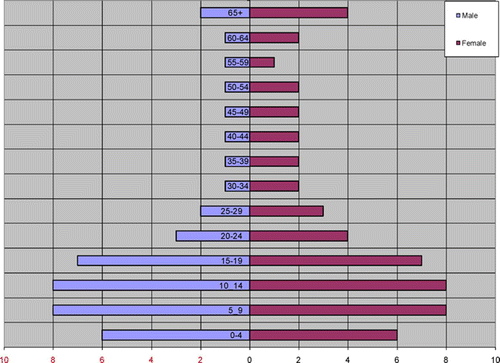
Figure 3. A pyramid of the rural former Ciskei population, 2001
Source: Statistics South Africa Citation(2001).
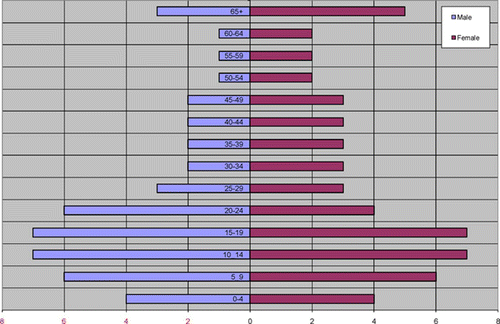
2.2 Changes in mean household size
Household size may contribute positively or negatively to household members' living circumstances. Where income is low, as is largely the case in the populations considered in this study, a large household size will have a negative impact on the members' material welfare. shows a progressive reduction in the mean size of households across the sub-regions compared. During the periods considered, the population of the former Transkei consistently had the largest mean household sizes, whereas the mean household sizes in the former Ciskei and the CFDs were consistently smaller than those of the black population nationally.
Table 2: Changes in mean household size amongst the rural black population
2.3 Changes in the mean number of children born to women of childbearing age
Both household size and high proportions of young dependants tend to be associated with large numbers of children born to women of childbearing age. shows that, in 1993, the mean number of children born to women who were 15 years and older in the study populations was highest in the former Transkei and lowest in the former Ciskei. The respective means had, however, decreased in both of these sub-regions by 1998, while the means for the CFDs had increased.
Table 3: Mean number of children per woman aged 15 years and older
2.4 Changes in adolescent childbearing
The age of women at the onset of childbearing has an effect on household size, the proportion of young dependants in each household and women's social developmental opportunities. shows the patterns of adolescent childbearing in the three populations. The former Transkei and CFD populations had high proportions of adolescent childbirths in 1993, but these had decreased by 1998 and more dramatically so for the CFDs. This declining trend can also be seen in the national and ECP provincial populations. The former Ciskei population, on the other hand, showed an increase in the proportion of adolescent childbirths in 1998.
Table 4: Adolescent births as a percentage of total births
2.5 Changes in infant and child mortality
Changes in infant and child mortality indicate the direction of changes in people's living conditions. shows that, in 1993, rural blacks nationally had higher infant and child death rates per thousand births than the national population. These rates were highest in the former Transkei, followed by those in the CFDs. The former Ciskei districts had the lowest figures, even compared with those of the black population nationally. The infant and child mortality estimates for 1993 were, however, based on the complete birth histories of the surveyed respondents and, thus, reflected the historical living conditions before 1993. The infant mortality figures derived from the 1998 SADHS, on the other hand, reflected the pattern of infant and child mortality during the preceding five years (Department of Health, Medical Research Council & Macro International, Citation1998). The difference in the figures for the two time periods looks less dramatic when the findings are understood in this way.
Table 5: Changes in infant and child mortality
2.6 Changes in migration patterns
The findings from the analysis of the migration patterns of the populations considered during the five years preceding 1993 and the five years preceding 2001 are shown in . The former Ciskei districts reflected much higher migration percentages than the former Transkei and CFDs. In addition, in the former Ciskei migration increased dramatically after 1993, while the CFDs reflected a very modest increase in migration and the former Transkei districts showed a decline.
Figure 4. Rural ECP migrants as a percentage of the sending population, 1993 and 2001
Source: South African Labour and Development Research Unit Citation(1993) and Statistics South Africa Citation(2001).
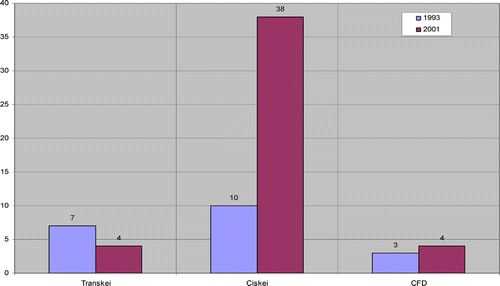
3. Changes in Gender Aspects of the Study Populations
This section reports on the changes in women's living conditions in the context of poverty among the rural black population of the ECP during the first ten years of democracy in South Africa.
3.1. Incidence of female household heads
shows that the ECP population consistently had higher percentages of households headed by women than the national population. The former Transkei in particular had consistently high percentages of female household heads, pushing the provincial percentage above the national average. In the CFDs, on the other hand, the percentages of female-headed households were much smaller but apparently growing. also shows the sharp increase in 2001 percentages of employed female household heads in both the former Ciskei and Transkei districts.
Table 6: Percentages of female household heads and their employment participation
Although the high percentages of female-headed households in the former Transkei and Ciskei districts may partly be attributed to employment-related out-migration of male household heads, analysis of data on the marital status of female household heads from the 2002 GHS indicated a high incidence of widowhood in the rural ECP (Statistics South Africa, Citation2002). shows that the percentages of widows exceeded those of married women in the five regional categories and the highest percentages were in the rural ECP. When the percentage of rural ECP widows is added to the percentages of divorced and unmarried household heads, an explanation for the high proportion of female-headed households emerges. This appears to indicate that substantial numbers of female household heads are de jure household heads, with the breadwinner connotations that accompany that status.
Figure 5. The marital status of female household heads in percentages, 2002
Source: Statistics South Africa Citation(2002).
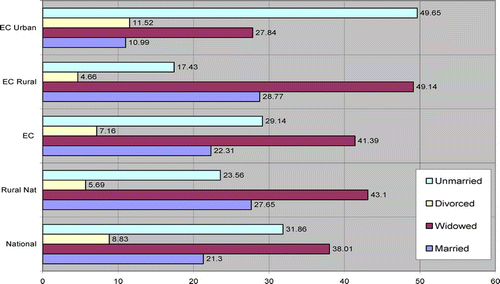
3.2 Women's participation in formal employment
Against the background of a high incidence of female-headed households in the study populations, the employment status of black rural female household heads becomes a pertinent issue. shows the employment trends among female household heads during the period considered in the analysis. It shows that rural black women's participation in employment declined both nationally and in the ECP between 1993 and 1998. Employment figures show that this decline was largest for the former Ciskei districts, followed by the CFDs. These two sub-regions had much higher levels of employment for women than the former Transkei districts in 1993. The sharp increases in the employment percentages of women in 2001 probably reflect the inclusion of informal sector employment in the census analyses, a sector known to have much lower incomes than the formal sector.
3.3 Changes in migration patterns among women
A further implication of the high percentages of female household heads in the study populations is women's internal migration compared with men's. shows that for the former Ciskei districts the percentage of female migrants slightly exceeded that of males in 1993 and that the differences in percentages of female and male migration in both the CFDs and the Transkei districts were small. In 2001, female migration in all three sub-regions exceeded male migration. This trend was marginal for the former Transkei districts and the CFDs but more pronounced for the former Ciskei districts.
Figure 6. Changes in migration patterns by gender
Source: South African Labour and Development Research Unit Citation(1993) and Statistics South Africa Citation(2001).
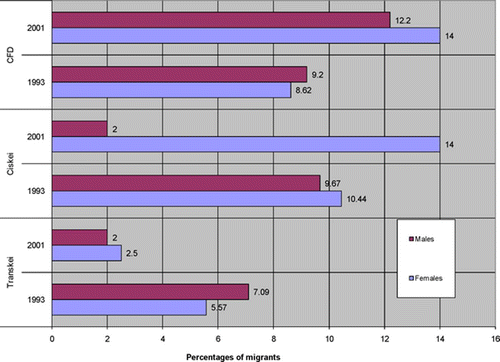
3.4 Rural women's employment by the various economic sectors
Analysis of rural women's participation in formal employment according to the sectors that employed them in 2002 revealed that, except for agriculture and crafts, the percentages of employment of rural ECP women in all employment categories were lower than those for employment of women nationally. shows the percentages of rural women in various employment categories, comparing the rural ECP with the national scenario for black women in 2002.
Figure 7. Rural women's employment by economic sector, 2002
Source: Statistics South Africa Citation(2002).
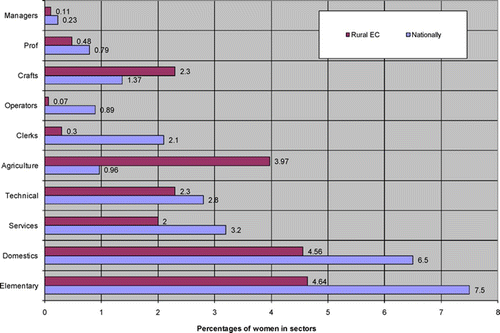
3.5 Rural women's educational achievement
While lack of employment opportunities could be the underlying reason for rural women's low participation in formal sector employment, their educational achievement could also be a contributing factor. compares the levels of literacy amongst black women in the study populations, the ECP and nationally using the 1998 SADHS data. Women in the former Ciskei districts have the highest percentage of literacy and those in the CFDs the lowest. With much lower literacy levels, the CFD population has the highest employment amongst women, reflecting the limited relevance of literacy for employment in the farming sector.
Table 7: Percentages of literacy among black women 30 years and older in 1998
The 2002 GHS (Statistics South Africa, Citation2002), using two categories for literacy and much larger samples than those used in the 1998 SADHS data, showed that the literacy levels of rural black ECP women were higher than those of rural black women nationally. The 2002 literacy estimates, however, could not be broken down into the rural strata used in this study.
reflect the trends that are emerging in both literacy and further educational achievements among rural women in the study populations who were 20 years and older. shows that illiteracy among Transkei women has increased in recent years and the percentages of women who had completed primary and secondary education reflect a declining trend. Only higher educational achievement shows a consistent but modest upward trend. By comparison, shows much lower percentages of illiteracy among women in the former Ciskei districts, even though consistent directional trends in literacy levels have yet to emerge. Completion of secondary education in the former Ciskei districts appears to be an established individual and social expectation and tertiary educational achievement shows consistent growth. shows a consistent growth in secondary and tertiary educational level achievement among women in the CFDs. Primary education completion reflects no consistent directional pattern, though the levels of illiteracy appear to be falling. The educational achievement of women in the study population is lower than that observed among their urban counterparts and the improvements in this regard are gradual.
Figure 8. Educational achievement of rural former Transkei women, 1993, 1998 and 2001
Source: South African Labour and Development Research Unit Citation(1993), Department of Health, Medical Research Council & Macro International Citation(1998) and Statistics South Africa Citation(2001).
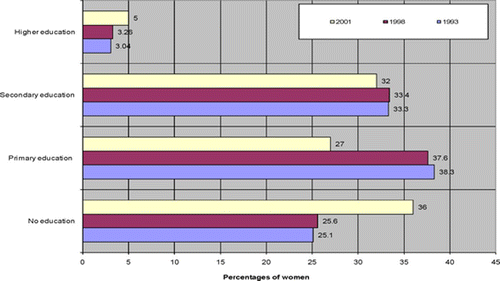
Figure 9. Rural women's educational achievement in former Ciskei districts, 1993, 1998 and 2001
Source: South African Labour and Development Research Unit Citation(1993), Department of Health, Medical Research Council & Macro International Citation(1998) and Statistics South Africa Citation(2001).

Figure 10. Rural women's educational achievement in CFDs, 1993, 1998 and 2001
Source: South African Labour and Development Research Unit Citation(1993), Department of Health, Medical Research Council & Macro International Citation(1998) and Statistics South Africa Citation(2001).
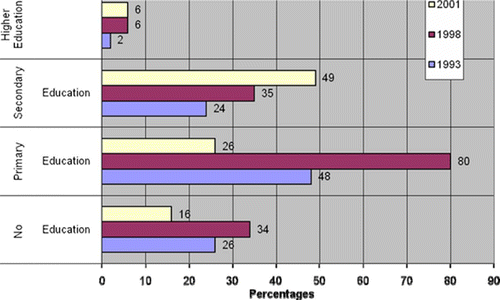
3.6 School enrolment of girls and women
The future trends in the educational achievement of women may be detected from the patterns of enrolment of female pupils. shows that the enrolment percentages for the female 16–24 years age group for 1993 and 1998 were consistently higher in the former Ciskei districts than in the other two regions. Enrolment figures for the CFDs were the lowest, though they showed a progressive rise during the three periods compared and were higher than the national figure in 2001.
Table 8: Trends in the enrolment of rural black women aged 16–24 years
An analysis of the enrolment of young girls aged from 6 to 15 years () within the poverty context might also reflect the socio-economic impact of the social grants introduced after 1994. The enrolment levels for rural black girls aged from 6 to 15 years over the period considered were once more consistently highest in the former Ciskei districts, surpassing the national and provincial enrolment figures, while those for the CFDs were the lowest in 1993 and 1998. The enrolment figures for the CFD population, however, rose progressively during the three periods compared and were equivalent to the national and Transkei figures in 2001. The former Transkei districts' enrolment figures, while high, reflected no consistent upward trend addressing the existing room for improvement.
Table 9: Trends in the enrolment of rural black women aged 6–15 years
4. Changes in Basic Service Accessibility for the Study Populations
Inadequate accessibility of basic household services such as energy, water and sanitation is a common aspect of poverty. This section looks at changes in the accessibility of these services for the study populations.
4.1 Changes in patterns of energy use for cooking
shows that, in 1993, the former Ciskei and CFD households used a combination of wood, paraffin and electricity for cooking, while the former Transkei households used only wood and paraffin. The percentage of households using wood for cooking decreased in both the CFD and former Ciskei districts between 1993 and 2001 and there was a shift towards more use of electricity. The largest decrease in the use of wood for cooking over the period considered was in the CFDs, where 60 per cent of all households had electricity for cooking, compared with 50 per cent nationally. In the former Ciskei districts the percentage of households using electricity for cooking in 2001 was almost double that of 1993. During the same period, the former Transkei rural households increased their use of wood for cooking and use of electricity was lowest there.
Figure 11. Rural ECP changes in energy use for cooking, 1993 and 1998
Source: South African Labour and Development Research Unit Citation(1993) and Department of Health, Medical Research Council & Macro International Citation(1998).
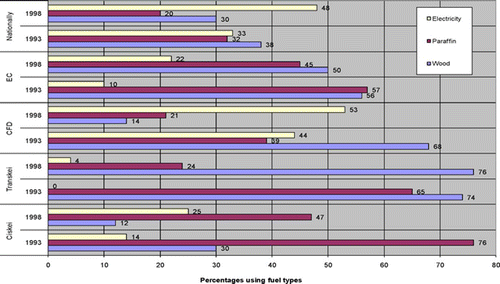
4.2 Changes in patterns of energy use for lighting
The use of candles remained high in the former Transkei districts, declining only slightly from 56 per cent in 1993 to 49 per cent in 2001. It was much lower in 1993 for the Ciskei (2 per cent) and CFD (7 per cent) households and the declines for these two areas were very small. It also declined nationally by nearly 10 per cent over the same period.
The use of paraffin for lighting decreased in the former Transkei and Ciskei districts between 1993 and 2001, reflecting a shift from paraffin to electricity. This shift was much more dramatic for the former Ciskei districts. In the CFD, on the other hand, there was a small reduction in the percentages of households using electricity for lighting and a small increase in the use of paraffin. However, use of electricity for lighting remained at between 50 and 60 per cent for the CFD households in 1993 and 2001 – higher than the percentage for the rural ECP and for black households nationally (see ).
Figure 12. Rural ECP changes in energy use for lighting, 1993 and 2001
Source: South African Labour and Development Research Unit Citation(1993) and Statistics South Africa Citation(2001).
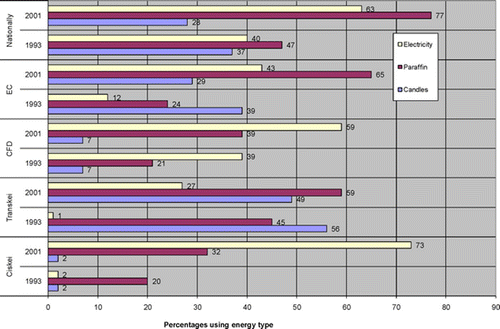
4.3 Households with safe water and households with no toilets
Except for the CFD households, rural households' access to safe water declined between 1993 and 2001. This decline was most pronounced among the former Transkei rural households, where it fell by more than 20 per cent. For the former Ciskei rural households there was a small decline of less than 1 per cent. Similar declines occurred nationally and across the ECP. However, it is unclear whether these declines are attributable to the methodological approaches used during the 1993 survey and the 2001 census. This requires further investigation.
As was the case with access to clean water, the CFD households were the only ones that showed improvements in the percentages of household use of toilets. The former Ciskei and Transkei households showed an increase in the percentages of households with no toilets between 1993 and 2001. Once more this finding raises methodological questions (see ).
Figure 13. Rural ECP safe water accessibility and availability of toilets, 1993 and 2001
Source: South African Labour and Development Research Unit Citation(1993) and Statistics South Africa Citation(2001).
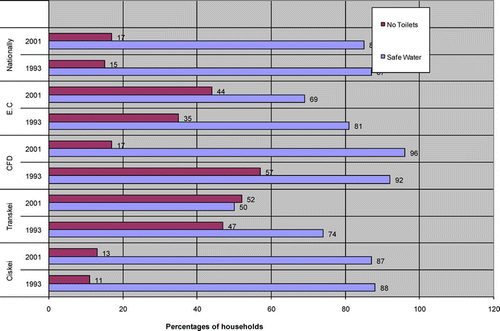
5. Changes in Agricultural Production and Employment in Commercial Farming
Analyses of rural poverty focus on agriculture since it is the major form of production for rural populations. At present agriculture is an important means of household production for the rural populations of the former Transkei and Ciskei districts, since the issue of equitable land distribution has yet to receive political attention. For the blacks living in the CFDs, agriculture is at present an important source of employment, since most of them have no access to land in the CFDs.
The 1998 RHS (Statistics South Africa, Citation1998) found that agriculture contributed approximately 4 per cent to rural households' incomes and that remittances and social transfers constituted the largest percentages of their incomes. This suggests a strong association between the rural population's low production and their poverty. The RHS analysis turned attention to accessibility of land as a resource for agricultural production.
5.1 Land use and access to land for agricultural production
The 2002 GHS (Statistics South Africa, Citation2002) revealed that 74 per cent of the sample of rural ECP households had access to land that could be used for agricultural purposes. This was true even for 76 per cent of the female household heads. However, 55 per cent of rural ECP respondents who had access to land had access to only 1 hectare and 12 per cent to 2 hectares of land. A further 26 per cent of households had access to 8 hectares of land and some 3 per cent had received a government land grant that helped them obtain land. The survey findings also revealed that 71 per cent of those with access to land did not use it for production and that 80 per cent of the households that did use the land produced crops, while 17 per cent used it for horticulture.
5.2 Livestock and poultry ownership
The 2002 GHS (Statistics South Africa, Citation2002) found that nearly 33 per cent of the black rural households owned large livestock. Such ownership, however, meant one unit of large livestock for 74 per cent of the households and two units for 17 per cent. Only one household in the sample had ten units of large livestock. The units of small livestock owned by most ECP rural households ranged from two to five. A significant percentage of households were engaged in poultry production, but 63 per cent of the sample owned fewer than ten units of poultry and 92 per cent owned fewer than 20. Only 8 per cent owned 20 and more units. , taken from De Swardt Citation(2002), illustrates the livestock ownership pattern in the Mt Frere district of the Transkei districts.
Table 10: Livestock ownership among a sample of rural African households in Mt Frere district, 2002
5.3 Employment in the agricultural sector
According to the Census of Agriculture (Central Statistical Services, Citation1993), blacks constituted 78 per cent of employees in the commercial farming sector of the ECP in 1993. The level of vulnerability of rural black households to the trends prevailing in that employment sector was therefore high. Employment in the agricultural sector declined both nationally and in the ECP. shows the national employment trends for regular and casual agricultural employment between 1988 and 1996. The decline in employment must be understood against a background of growing rural populations and as thus contributing to rural poverty. Arguments that the commercial farming sector resorts to casual labour to reduce production costs are inadequately substantiated by the employment figures. The available data on employment in ECP commercial farming is limited to the years 1991–6 and shows that the decline in regular employees occurred along with a decline in casual labour employment up to 1994, as shown in . However, there was a modest increase in the use of casual labour between 1995 and 1996 and this may have persisted.
Figure 14. Employment trends in the South African commercial farming sector, 1988–96
Source: Statistics South Africa Citation(1996).
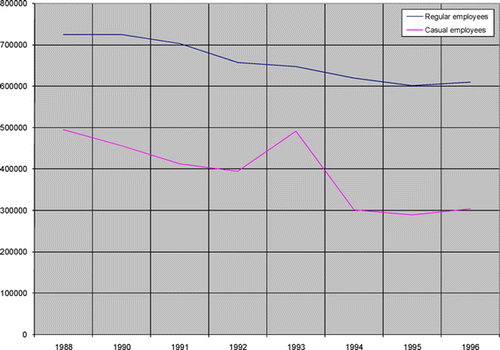
Figure 15. Employment in ECP commercial farming, 1991–6
Source: Statistics South Africa Citation(1996).

6. Discussion of the Findings and their Implications for Poverty Alleviation Strategies
6.1 Demographic changes
On the often passionately contested subject of population and development, both the Population Policy for South Africa (Department of Welfare, Citation1998) and the Programme of Action adopted at the International Conference on Population and Development in Cairo in 1994 (United Nations, Citation1994) emphasise the reciprocal relationship between poverty and population dynamics. Against that background, the overall tendency towards smaller household sizes, a lower mean number of childbirths to women of childbearing age and a decrease in adolescent childbirths all suggest that reproductive health services are becoming more accessible for rural women, which is bringing about a decline in the proportions of young dependants. The declining infant mortality rate also indicates that health services are becoming more accessible and that childbearing patterns are taking account of the rural economic realities. However, sub-regional variations in the pace of these changes were identified and their pattern was confirmed by an analysis conducted by Hutchison et al. Citation(2004). In that analysis, the ECP population was stratified as rural non-Transkei, urban non-Transkei and former Transkei. The researchers noted the gap between the former Transkei and the other rural areas in the various demographic and health changes. The findings on changes in infant mortality, for instance, indicated that ameliorative interventions have had a selective geographic impact that left the former Transkei municipal districts at the margins of improvements in infant mortality figures in the ECP.
The growing percentages of old dependants in the former Ciskei suggests that, demographically, this population is ageing, which warrants attention from the perspectives of health and social care for senior citizens. The deficit of working age males is significant for development and production strategies for both the former Transkei and former Ciskei districts, where development must necessarily focus strongly on women and youth. The growing incidence of female-headed households in the study populations appears to be attributable largely to high male mortality and emphasises the important role women have to play in the contexts considered. The increase in women's migration in the former Ciskei districts shows that women are stepping into the household head vacuum created by male mortality and that male out-migration is apparently playing a secondary role in rural household economy. The decline in migration in the former Transkei districts points to the need for long-term investment in sustainable labour-intensive rural production activities, including agriculture.
6.2 Gender aspects
Literacy and educational achievement are highest amongst Ciskei women and this most likely gives them a competitive edge in the South African employment market, in which women from the rural ECP tend to be employed in the low-paying sectors. The former Ciskei districts also had higher school enrolment figures across age groups than the two other sub-regions. This once more calls for the sub-regional discrepancies in women's education to be identified and addressed.
Rural women's socio-economic position as heads of households emphasises the need to strengthen women's economic and social role in South African society. The traditional justifications for women's exclusion from mainstream economic, political and social agendas are challenged by women's need to support their households alongside their partners and without them if they should die or abandon them. The growing educational participation of rural women therefore warrants continuous monitoring to facilitate women's economic participation and skills development in line with South Africa's labour market demands.
6.3 Service access
On rural provision of energy, water and sanitation, the findings of this study indicated that improvements in access to these services vary considerably across the sub-regions that were compared and that for the former Ciskei and CFDs the achievements have been considerable, even though there is still much room for improvement. The 1993 baseline scenarios for these two regions were, however, much better than those for the former Transkei rural districts, which started off at much lower levels of service access and will therefore require much more intensive interventions to narrow the service gaps between them and the other rural populations and between them and the urban populations. The extensive use of wood for cooking among the former Transkei households reflects not only their difficult living conditions but also the impact poverty is having on their physical environment, causing a downward environmental spiral. The gap between the former Transkei's access to electricity and that of the other two areas appears to be widening, both for cooking and for lighting. This scenario once more seems to suggest that the largest and poorest residential rural districts in the ECP are being marginalised. Since electricity brings multiple benefits, the households doing without it are thus becoming even more disadvantaged.
The report on poverty and inequality in South Africa (Carter & May, Citation1998) commented on how the absence of potable water and sanitation services makes people vulnerable to poor health, reducing both their quality of life and their productive capacity and burdening health care and social welfare services. This observation clearly indicates that service access for the rural poor remains a big challenge for ECP society.
6.4 Agricultural production and employment trends
The findings of this study suggest that, for the former Transkei and Ciskei rural population, inadequate access to land may not necessarily be the underlying cause of low agricultural production, since the small amount of land available to households is frequently not put to productive use. Where it is put to use, the production tends to fall below subsistence level. In a survey of 733 rural households in the Mt Frere district of the Transkei districts, De Swardt Citation(2002) found that 87 per cent of them relied on bought maize for household use and only 5 per cent produced sufficient maize for domestic use. In addition, food expenditure accounted for 44 per cent of the total household expenditures in his sample. The question of why agricultural land is extensively under-used does not appear to attract research attention but is the subject of speculation. The most common explanation is that the units of land allocated under land tenure are sub-economical. This is, however, an unsatisfactory explanation, since there is no legislation that prohibits interested producers from borrowing or renting unused land from fellow community members who are unable to use it, because of either labour or economic constraints. Economic constraints and their attendant risk aversion are seldom put forward as the underlying reason why land is not used. Agricultural inputs are most probably out of reach for most households, since agricultural production basically constitutes an investment and, like all investments, requires delay or postponement of consumption. The percentage of households that can afford such delays in income consumption may be too small and the attendant risks too high. The potential of both agricultural and pastoral farming to help alleviate poverty among the affected populations has yet to be targeted and will require considerable investment by the government. Agricultural production is probably the most sustainable route to improved rural living standards and massive governmental support is needed to set the rural populations of the ECP on that course. The declining employment in the CFDs demonstrates how formal employment is becoming an unreliable contributor to improved living conditions for rural populations.
7. Conclusion: Recommendations for Future Research on Rural Poverty
To sum up, from a research perspective poverty warrants analysis at multiple levels, including the identification of priority geographic areas for intervention in each aspect of poverty. Rural communities frequently become victims of marginalisation, despite the fact that the Millennium Development Goals for poverty alleviation challenge governments to make rural populations priority areas for poverty alleviation interventions. It is incumbent on democratic governance to commit itself to equity and as far as possible avoid marginalising these communities.
References
- Agarwal , B . 1994 . A field of one's own: gender and land rights in South Asia , New York : Cambridge University Press .
- Bage , L . 2002 . Investment in rural and agricultural development: a sharp and decisive increase needed . The Courier , 195 : 2 – 3 .
- Bartoli , H . 2000 . Rethinking development: putting an end to poverty , Paris : UNESCO .
- Caldwell , JC and Caldwell , P . 1993 . The South African fertility decline . Population and Development Review , 19 ( 2 ) : 225 – 61 .
- Carter , MR and May , J . 1998 . Poverty and inequality in South Africa Pretoria Report prepared for the Office of the Executive Deputy President and the Inter-Ministerial Committee for Poverty and Inequality
- Central Statistical Services . 1993 . Census of Agriculture, Eastern Cape , Pretoria : Central Statistical Services .
- De Swardt , C . International conference on Staying Poor, Chronic Poverty and Development Policy. Unravelling chronic poverty in South Africa: some food for thought , http://wwwchronicpoverty.org/news_events/Apr2003-conferencepapers.htm Accessed 20 October 2007
- Department Of Health, Medical Research Council & Macro International . 1998 . The South African Demographic and Health Survey , Pretoria : Government Printer .
- Department Of Welfare . 1998 . Population policy for South Africa , Pretoria : Ministry of Welfare and Population Development .
- El-ghonemy , M . 1990 . The political economy of rural poverty , London : Routledge .
- Erasmus , J . 1996 . Eastern Cape: a human development profile , Halfway House, , South Africa : Development Bank of South Africa, Centre for Policy and Information . Development Paper 108
- Hamilton , D . 1968 . A primer on the economics of poverty , New York : Random House .
- Human Sciences Research Council . 1987 . The Demographic and Health Survey , Pretoria : Human Sciences Research Council .
- Human Sciences Research Council . 2004 . Fact Sheet: poverty in South Africa , Vol. 1(26) , Pretoria : Human Sciences Research Council . 2001 http://www.sarpnorg.za/documents/d0000990/P1096-Fact_Sheet_No_1_Poverty.pdf Accessed 20 October 2007
- Hutchison , P , Boerma , JT and Khan , M . 2004 . 1998 Demographic and Health Survey for the Eastern Cape Province Equity Project , http://www.cpc.unc.edu/measure/publications/index.php Accessed 20 October 2007
- Lipton , M . 1985 . Land assets and rural poverty , Washington, DC : World Bank . World Bank Staff Working Papers No. 744
- Lipton , M . 1996 . “ Rural reforms and rural livelihoods: the contexts of international experience ” . In Land, labour and livelihoods in South Africa, Volume 1 , Edited by: Lipton , M , De Klerk , M and Lipton , M . Durban : Indicator Press .
- Mencarini , L . pre-conference proceedings of Third African Population Conference, African Population in the 21st Century . December 6–10 , Durban, South Africa. An analysis of fertility and infant mortality in South Africa based on 1993 LSDS Data , Dakar, Senegal : Union of African Population Studies .
- Potts , D and Marks , S . 2001 . Fertility in southern Africa: the quiet revolution . Journal of Southern African Studies , 27 ( 2 ) : 189 – 205 .
- South African Institute of Race Relations . 2001 . South Africa Survey, 2000/2001 , Johannesburg : South African Institute of Race Relations .
- South African Labour And Development Research Unit . 1993 . Project for Statistics on Living Standards and Development (PSLSD) , Cape Town : South African Labour and Development Research Unit .
- Smith , AG . 1997 . Human rights and choice in poverty , London : Praeger .
- Statistics South Africa . 1995 . October Household Survey , Pretoria : Statistics South Africa .
- Statistics South Africa . 1996 . Agricultural Surveys, 1994, 1995 and 1996 , Pretoria : Statistics South Africa .
- Statistics South Africa . 1998 . Rural Household Survey , Pretoria : Statistics South Africa .
- Statistics South Africa . 2001 . Census 2001 , Pretoria : Statistics South Africa .
- Statistics South Africa . 2002 . General Household Survey , Pretoria : Statistics South Africa .
- Torres , L , Bhorat , H , Leibbrandt , M and Cassim , F . 2000 . “ Poverty and the labour market ” . In Poverty and inequality in South Africa: meeting the challenge , Edited by: May , J . Cape Town : David Philip .
- United Nations . Programme of Action adopted at the International conference on Population and Developmen . September 5–13 , Cairo. New York : United Nations .
- Whiteford , A , Posel , D and Kelatwang , T . 1995 . A profile of poverty, inequality and human development , Pretoria : Human Sciences Research Council .